Carotid artery stenosis
Last reviewed: 23.04.2024

All iLive content is medically reviewed or fact checked to ensure as much factual accuracy as possible.
We have strict sourcing guidelines and only link to reputable media sites, academic research institutions and, whenever possible, medically peer reviewed studies. Note that the numbers in parentheses ([1], [2], etc.) are clickable links to these studies.
If you feel that any of our content is inaccurate, out-of-date, or otherwise questionable, please select it and press Ctrl + Enter.
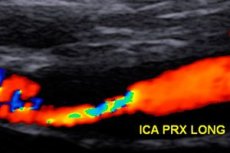
Arteries deliver blood, saturated with oxygen, internal organs. With the help of carotid arteries, which are located on both sides of the neck, arterial blood is delivered to the brain. Stenosis of the carotid arteries is idiopathic or due to atherosclerosis, narrowing of one or two arteries.
Causes of the stenosis of the carotid artery
Among the main causes and risk factors for the development of carotid artery stenosis, angiologists call:
- Hereditary factor (if atherosclerosis was detected in family members, then their direct relatives can develop carotid artery stenosis).
- Elderly age - as a rule, this disease is more often manifested in people older than 70 years.
- Sexual signs - usually stenosis of the carotid artery is more common in women.
- Hypertension.
- Nicotine addiction.
- Diabetes mellitus type 1 or type 2.
- Hypodinamy.
- Improper diet
- Excess weight metabolic disorders.
Symptoms of the stenosis of the carotid artery
Specific signs in this disease are absent, but there are a number of signs that may indicate a mini-stroke or TIA:
- Rapid and sudden deterioration of visual acuity. In this case, both one eye and one eye can be immediately affected.
- Numbness of one half of the face. There may be weakness in the arms and legs on one side.
- A person may not understand what others say to him. His speech becomes incoherent and little understood.
- Violation of coordination of movements.
- Confusion, vertigo.
- Difficulty swallowing act.
Stenosis of the internal, general, right or left internal carotid artery develops in most cases due to atherosclerotic plaque, hypercholesterolemia.
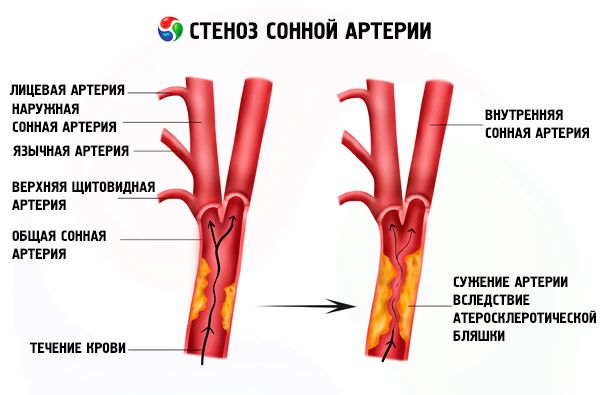
Often atherosclerotic plaques of this localization can lead to the development of ischemic stroke and the corresponding symptoms: numbness of the limbs, face, dizziness, headaches.
Diagnostics of the stenosis of the carotid artery
The following diagnostic methods are used to diagnose stenosis of the carotid artery:
- Ultrasound is a study that helps to study carotid arteries for narrowing.
- The method of antigraphy is an invasive examination that is performed by inserting a special catheter into the artery on the arm or leg. Through it, then a special contrast agent is introduced and a series of X-ray photographs is performed. This method helps not only to see where the artery is narrowed, but also to carefully consider all the details of the lesion.
- MRA - with the introduction of a contrast agent, the carotid artery is scanned. Thanks to magnetic resonance angiography, a radiologist can obtain more information about constriction.
- CT - this method is used only if there is a risk of developing ischemic stroke or transient ischemic attacks.
What do need to examine?
Who to contact?
Treatment of the stenosis of the carotid artery
First of all, the patient should completely change his habitual way of life. It is necessary to give up smoking, alcohol abuse, control the level of cholesterol in the blood with the help of a hypocholesterolemic diet.
Also prescribed and medication. The most popular among them are antiplatelet agents. These funds can reduce the risk of complications in the form of myocardial infarction and stroke. Most often, patients are prescribed acetylsalicylic acid, clopidorgel, dipyridamole. Also prescribed drugs from the group of anticoagulants, for example Warfarin.
Operation in stenosis of the carotid artery
Typically, the method of choice for atherosclerotic stenosis of the carotid arteries is carotid endarterectomy. It is performed only in patients with a carotid artery stenosis level of more than 50%.
During surgery, the angiosurgeon makes a small incision on the neck and removes thrombotic clumps and atherosclerotic plaques. Next, stitching of the artery and the application of sutures.
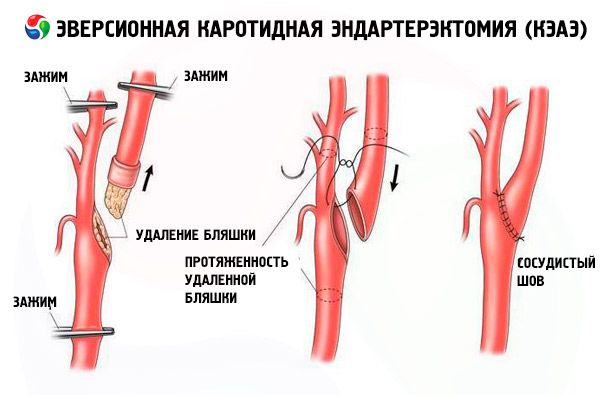
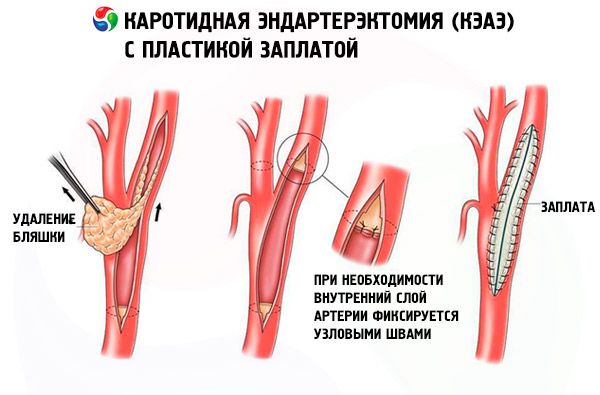
Stenting - the procedure of placement in the narrowed, due to atherosclerosis, part of the carotid artery of the stent, (duct from the metal of the cellular structure).
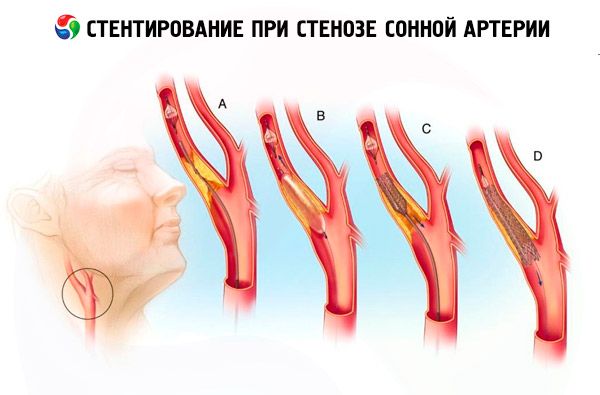
Inside the artery, the stent gradually opens, pushing the narrowed section and restoring the lumen, improves blood circulation and oxygenation of the brain. After 1-3 days after the stenting procedure, the patient is usually discharged home.


 [
[